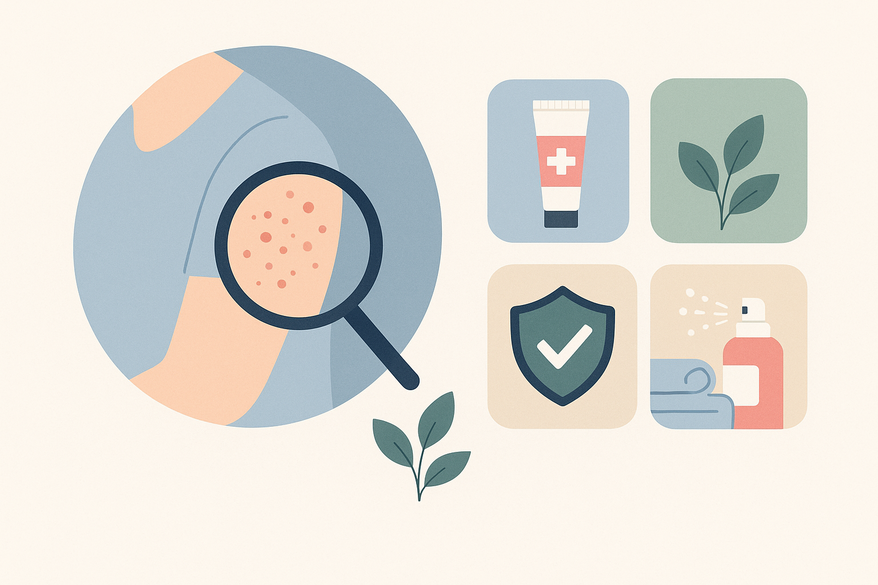Common Rashes in Older Adults: An Essential Guide to Recognition and Care
Discover how to recognize, manage, and prevent common rashes in older adults. This guide covers symptoms, treatments, and preventive measures for dermatological health.

Estimated reading time: 7 minutes
Key Takeaways
- Skin aging leads to decreased elasticity, dryness, and slower healing, increasing rash susceptibility in seniors.
- Seven common rashes: eczema, contact dermatitis, seborrheic dermatitis, fungal infections, shingles, pressure sores, scabies.
- Diagnosis relies on visual inspection, patient history, and simple tests like skin scrapings.
- Management includes gentle skin care, targeted treatments (topical steroids, antifungals, antivirals), and prevention strategies.
- Prevention: consistent moisturization, sun protection, repositioning immobile individuals, and controlling chronic conditions.
Table of Contents
- Overview of Aging and Skin Health
- Detailed Discussion of Common Rashes
- Causes and Risk Factors
- Diagnosis and When to Seek Medical Advice
- Management and Treatment Options
- Conclusion
I. Overview of Aging and Skin Health
As we age, our skin undergoes structural changes—thinning, loss of collagen and elastin, reduced sebum production, slower healing, and immune senescence. These factors set the stage for various rashes common in older adults.
- Decreased elasticity: thinner, more fragile skin prone to tears.
- Increased dryness: flaky, itchy patches due to oil decline.
- Slower healing: minor wounds linger, raising infection risk.
- Immune senescence: less effective defense against pathogens.
II. Detailed Discussion of Common Rashes
Here are the seven most frequent dermatological conditions in seniors:
1. Eczema (Atopic Dermatitis)
- Definition: chronic inflammatory disease with barrier dysfunction.
- Appearance: red, scaly plaques that may ooze or crust.
- Symptoms: intense itching, burning, rough texture.
- Typical locations: flexural areas, neck, trunk.
2. Contact Dermatitis
- Definition: irritation after skin contact with allergens or irritants.
- Appearance: red, swollen, blistered or crusted patches.
- Symptoms: burning, stinging, itching.
- Locations: hands, face, forearms.
3. Seborrheic Dermatitis
- Definition: chronic inflammation in oil-rich regions.
- Appearance: greasy, yellowish scales on red background.
- Symptoms: mild itch, visible flaking.
- Locations: scalp, eyebrows, nasolabial folds, chest.
4. Fungal Infections (Tinea, Candidiasis)
- Definition: dermatophyte or yeast infections.
- Appearance: ring-shaped rashes, scaling edges.
- Symptoms: itching, burning in skin folds.
- Locations: feet, groin, under breasts, nails.
5. Shingles (Herpes Zoster)
- Definition: varicella-zoster reactivation.
- Appearance: painful, blistering rash following a dermatome.
- Symptoms: tingling, stabbing pain, then grouped vesicles.
- Locations: unilateral band on trunk or face.
6. Pressure Sores (Decubitus Ulcers)
- Definition: tissue breakdown from prolonged pressure over bony areas.
- Appearance: red, non-blanching areas progressing to ulcers.
- Symptoms: localized pain, infection risk.
- Locations: heels, hips, sacrum, elbows.
7. Scabies
- Definition: infestation by Sarcoptes scabiei mites.
- Appearance: burrow tracks, pimple-like rash.
- Symptoms: intense nocturnal itching.
- Locations: finger webs, wrists, waist.
III. Causes and Risk Factors
- Environmental exposures: UV radiation, harsh detergents, allergens.
- Polypharmacy: drug-induced photosensitivity or allergic reactions.
- Chronic diseases: diabetes, vascular disorders impair skin integrity.
- Immobility: increased pressure sore risk.
- Autoimmune/metabolic disorders: lupus, thyroid disease can manifest on skin.
IV. Diagnosis and When to Seek Medical Advice
Accurate diagnosis is key:
- Visual assessment: note pattern, distribution, color, scaling.
- Patient history: check exposures, new meds, health conditions.
- Tests: skin scrapings, swabs, or biopsy if needed.
Seek professional help if you notice widespread rash, severe pain, fever, signs of infection, or no improvement after 1–2 weeks.
V. Management and Treatment Options
A. General Skin Care Measures
- Moisturize: fragrance-free, ceramide-rich creams daily.
- Gentle cleansing: pH-balanced cleansers; avoid hot water.
- Soothing therapies: cooling compresses, wet wraps for itch relief.
For quick preliminary screening, tools like Rash Detector offer AI-based analysis of photos. Below is a sample report demonstrating an instant overview of rash characteristics:

B. Specific Treatments by Condition
- Eczema & contact dermatitis: topical corticosteroids or calcineurin inhibitors.
- Fungal infections: topical antifungals (e.g., terbinafine, clotrimazole).
- Shingles: oral antivirals within 72 hours of rash onset.
- Bacterial complications: topical/oral antibiotics (e.g., mupirocin, cephalexin).
- Scabies: permethrin 5% cream or oral ivermectin; treat close contacts.
C. Prevention and Long-Term Care
- Avoid known irritants/allergens.
- Sun protection: broad-spectrum SPF 30+, protective clothing.
- Reposition immobile seniors every two hours.
- Regular skin inspections by caregivers.
- Control chronic diseases (e.g., blood glucose).
VI. Conclusion
The prevalence of rashes in older adults stems from natural skin aging, health factors, and environmental triggers. Early detection and tailored management can enhance comfort and prevent complications.
- Understand aging skin vulnerabilities.
- Recognize key rash types.
- Implement gentle care and know when to seek help.
- Adopt prevention strategies: moisturization, sun safety, repositioning, disease control.
For further guidance:
American Academy of Dermatology
National Council on Aging
Elderly Rash Management & Prevention
Comprehensive Elderly Rash Treatment
Consult a dermatologist or primary care provider for personalized advice.
FAQ
- What causes skin to become more prone to rashes with age?
Aging leads to thinner skin, reduced oils, slower healing, and immune changes that increase rash risk. - When should a rash in an older adult prompt medical attention?
Seek help if a rash is widespread, painful, accompanied by fever, shows infection signs, or doesn’t improve after 1–2 weeks. - How can I prevent pressure sores?
Regularly reposition immobile individuals, maintain skin hygiene, and use pressure-relieving supports. - Are over-the-counter treatments effective for fungal infections?
Yes, topical antifungals like terbinafine are often effective; persistent cases may need prescription-strength options.





